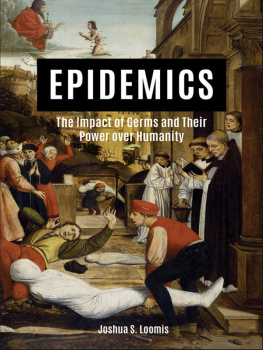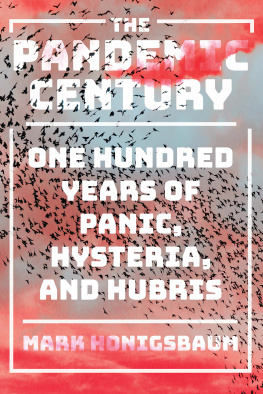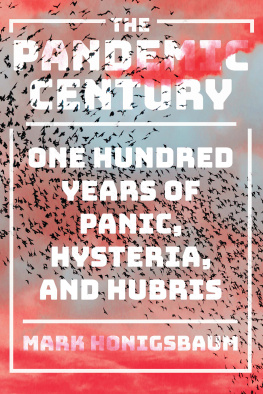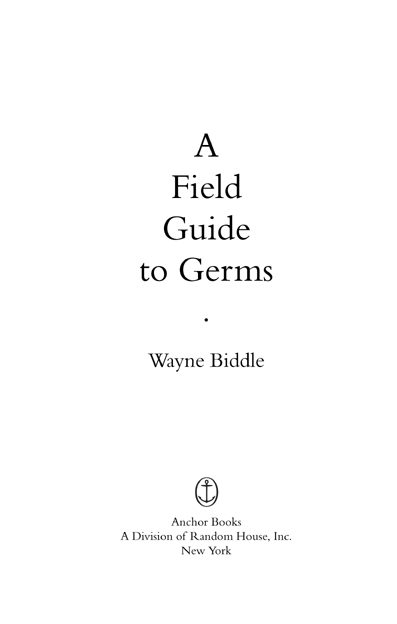Wayne Biddle
A Field Guide to Germs
Wayne Biddle is the author of four other books: Barons of the Sky, a history of the American aerospace weapons business; A Field Guide to the Invisible, a catalog of things beyond our senses; Coming to Terms, about scientific jargon; and Dark Side of the Moon, a history of Wernher von Braun, the Third Reich, and the space race. He is on the faculty of the Writing Seminars at Johns Hopkins University and lives in rural Maryland.
ALSO BY WAYNE BIDDLE
Coming to Terms
Barons of the Sky
A Field Guide to the Invisible
Dark Side of the Moon
THIRD ANCHOR BOOKS EDITION, MARCH 2010
Copyright 1995, 2002, 2010 by Wayne Biddle
All rights reserved. Published in the United States by Anchor Books, a division of Random House, Inc., New York, and simultaneously in Canada by Random House of Canada Limited, Toronto. Originally published in hardcover in the United States by Henry Holt & Co., in 1995, and in paperback in slightly different form by Anchor Books, a division of Random House, Inc., in 1996 and 2002.
Anchor Books and colophon are registered trademarks of Random House, Inc.
Library of Congress Cataloging-in-Publication Data is on file.
eISBN: 978-0-345-80463-1
www.anchorbooks.com
v3.1
Nous sommes dmocratiss et syphiliss.
Baudelaire
Contents
Illustrations
An Egyptian stele, or stone tablet, from the eighteenth dynasty. Courtesy of March of Dimes Birth Defects Foundation.
French chemist and microbiologist Louis Pasteur (18221895) with his granddaughter. Courtesy of National Library of Medicine.
German bacteriologist Robert Koch (18431910) and his wife. Courtesy of National Library of Medicine.
Fresh AIDS virus budding from the membranes of infected T-4 lymphocytes. Courtesy of Centers for Disease Control and Prevention.
Young suitor kneeling before Death disguised as a beautiful girl. Courtesy of National Library of Medicine.
A woodcut from Thomas Bartholins Historiarium anatomicarum (16541661) showing a doctor garbed against the Plague. Courtesy of National Library of Medicine.
An early-nineteenth-century caricature of hypochondria and pseudoprotective measures against cholera. Courtesy of National Library of Medicine.
Trying to make the best of quarantine on Ellis Island, New York. Courtesy of National Library of Medicine.
Science sleeps on a New York dock as Cholera floats across the ocean from Europe. Courtesy of Library of Congress.
She May Look CleanBut. Courtesy of National Library of Medicine.
Anthrax cells. Courtesy of Dr. Edward J. Bottone.
Lyme disease poster. Courtesy of National Library of Medicine.
Cholera poster. Courtesy of National Library of Medicine.
An early-nineteenth-century German illustration of a man wearing protective gear against cholera. Courtesy of National Library of Medicine.
An illustration published in London in 1832 showing two physicians bundling up a cholera patient. Courtesy of National Library of Medicine.
Epidemic in Marseilles, 1865. Courtesy of National Library of Medicine.
Board of Health quarantine notice, San Francisco, circa 1910. Courtesy of National Library of Medicine.
AIDS virus. Courtesy of Centers for Disease Control and Prevention.
AIDS virus particles found in a patient with hemophilia. Courtesy of Centers for Disease Control and Prevention.
Gerald Fords nemesis, the swine flu virus. Courtesy of Centers for Disease Control and Prevention.
Human liver infected with the Ebola virus. Courtesy of Centers for Disease Control and Prevention.
A Centers for Disease Control worker exposed to the Ebola virus. Courtesy of National Library of Medicine.
A Japanese woodcut, circa 1900, showing measles as an especially hirsute demon. Courtesy of National Library of Medicine.
Rubella virus. Courtesy of Centers for Disease Control and Prevention.
Mumps virus. Courtesy of Centers for Disease Control and Prevention.
A Memory of the Mumps, Harpers Weekly, 1860. Courtesy of National Library of Medicine.
Penicillin Cures Gonorrhea in 4 hours. Courtesy of National Library of Medicine.
Gonorrhea, the Great Sterilizer. Courtesy of National Library of Medicine.
Malaria poster. Courtesy of National Library of Medicine.
Red blood cells infected with plasmodium. Courtesy of Dr. Edward J. Bottone.
The War with Malaria, a Soviet educational poster. Courtesy of National Library of Medicine.
Board of Health quarantine notice, San Francisco, circa 1910. Courtesy of National Library of Medicine.
Elvis gets his polio shot. Courtesy of March of Dimes Birth Defects Foundation.
A cartoon published in 1826 shows a rabid dog causing panic in the streets of London. Courtesy of National Library of Medicine.
Sopona, god of smallpox, worshiped by the Yorubas of Nigeria. Courtesy of World Health Organization.
Shitala Mata, Indian goddess of smallpox. Courtesy of World Health Organization.
Lady Mary Wortley Montagu (16891762). Courtesy of National Library of Medicine.
A milkmaids hand. Courtesy of National Library of Medicine.
An antivaccination society illustration, London, 1802. Courtesy of National Library of Medicine.
Staphylococcus bacteria. Courtesy of Dr. Edward J. Bottone.
Twisting chains of Streptococcus bacteria. Courtesy of Dr. Edward J. Bottone.
Pneumococcus cells. Courtesy of Dr. Edward J. Bottone.
Juke Joint Sniper. Courtesy of National Library of Medicine.
French TB poster. Courtesy of National Library of Medicine.
Your Lungs, Germine Company TB poster. Courtesy of National Library of Medicine.
The Next to Go, Red Cross Christmas Seal Campaign TB poster. Courtesy of National Library of Medicine.
Chicken pox virus. Courtesy of Centers for Disease Control and Prevention.
Ascaris lumbricoides, or roundworm, infects a billion people worldwide. Courtesy of Dr. Edward J. Bottone.
An Aedes aegypti mosquito, first identified as the carrier of yellow fever in 1881. Courtesy of American Museum of Natural History.
A nineteenth-century cartoon showing Columbia rescuing Florida from Yellow Jack. Courtesy of Library of Congress.
Plague bacteria. Courtesy of Dr. Edward J. Bottone.
Scientists examining rats for bubonic plague in New Orleans, 1914. Courtesy of National Library of Medicine.
The Plague Pit, an early-nineteenth-century engraving. Courtesy of National Library of Medicine.
An angel tells Charlemagne of a plant that can stop the Plague. Courtesy of National Library of Medicine.












